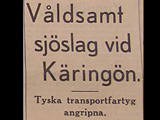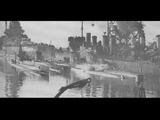War in the Kattegat 1939-1945.
A article in seven parts.

Part 2: 1940
On January 17, the British submarine HMS Tribune fired six torpedoes at 0250 hrs against a suspected German submarine northeast of Skagen. At 0253 hrs, two more torpedoes were launched, but no German submarine was noted in the area.
On March 21, the British submarine HMS Ursula sank the transport ship Heddernheim with a torpedo in the Kattegat. Heddernheim was at the time on its way from Norway to Germany with ore.
At 1pm on April 2, the British submarine HMS Sunfish left Harwich in England to patrol the Kattegat.
On April 3, at 1412 hrs, a German bomber passed over the island Getterön in Varberg at an altitude of 300 m. The plane was fired upon from the Swedish side and turned north towards Bua, whereafter it continued out to sea at 1440 hrs. Probably the crew of the plane had oriented incorrectly in the poor visibility that prevailed at the time.
On April 7, British and French submarines were ordered to take positions in the Kattegat and Skagerrak to prevent German counterattacks during Operation Wilfred, which was a British operation aimed at making it difficult for Germans to transport iron ore from Norway by mining the waters. The mine laying was carried out at dawn on April 8 and they were allowed to operate undisturbed and after one hour all the mines had been laid out. During the operation, 19 British and French submarines patrolled the Kattegat and Skagerrak before being interrupted two days later due to the Germans invading Norway on 9 April. The English and French mines were seen as a major violation of Norwegian neutrality. After the German invasion of Norway began on 9 April, the British submarines continued to be active in the Kattegat and Skagerrak until 1 May to disrupt German ships on their way to and from Norway.
On April 9, the Germans staged Operation Weserübung, the invasion of Denmark and Norway.
The purpose of the operation was to gain control of the ports along the coast of Norway, among other things to secure the important iron ore transports from Kiruna for the war industry, which were shipped out of Narvik and further down to Germany past Denmark. Another reason for the invasion of Norway was that the Germans wanted to increase their territory from which they could attack Britain and guard the waterways towards Murmansk in Russia. During the preparations for the invasion, many ships with troops, munitions, fuel, and supplies passed through the Kattegat on their way to Norway. After the invasion, these transports to and from Norway continued through the Kattegat.
The invasion of Norway did not come as a surprise to the British, who had long ago known that the Germans had converted merchant ships into troop transport ships and that a large number of German ships had gathered in ports in the Baltic Sea and in the mouth of the Elbe. However, it was not known that it was Norway that the Germans intended to invade. After the invasion of Norway, the then Prime Minister of the United Kingdom, Churchill, pointed out that British submarines had already sunk several German troops and materiel ships and further assured that soon all German ships in the Kattegat and Skagerrak would be sunk. The Germans had previously been able to move freely within the territorial waters of Norway and Sweden due to the countries' neutrality. Churchill pointed out that this Norwegian corridor no longer existed after the German invasion. Watching when iron ore was transported undisturbed down to Germany to become grenades against England and France was not accepted and it was also known that the Germans used ore vessels to send troops to Norway.
On April 10, the troop transport ships Friedenau and Wigbert were sunk along with one of their convoy safety vessels, V-1507, by the British submarine HMS Triton. The convoy, Seetransportstaffel 2, had left Poland two days earlier to go to Oslo with troops, horses, vehicles, and other equipment.
On the same day that Friedenau, Wigbert and V-1507 were torpedoed, the German transport ships Amasis and Antares, which had left Stettin at night, three days earlier, together with the convoy Seetransportstaffel 1 to go to Oslo with munitions, were also sunk. The two ships were sunk by the British submarine HMS Sunfish, which has been waiting at the Måseskär since 9 April after receiving information about the convoy that was heading north through the Kattegat.
On April 11, the German troop transport ship August Leonhardt was torpedoed and sunk
southeast of Anholt by the British submarine HMS Sealion.
At night on April 13, the British submarine HMS Sunfish, which had sunk Amasis and Antares three days earlier, spotted the German steamship Schürbeck while listening for activity at the bottom of the Käringfjord. The transport ship Schürbeck was at the time heading south and during the night the German ship was sunk by a torpedo from Sunfish.
On 13 April, the British submarine HMS Narwhal laid 50 mines outside Fredrikshamn. In Hallandsposten it was reported that the Kattegat was mined but that the mines did not affect Swedish territorial waters. The purpose of the British mines was to stop the ore road to Germany. From the Swedish coast, a 20 nautical mile wide opening was left for neutral shipping.
Outside Käringön, heavy detonations were heard at noon on 13 April. A German troop transport ship with a strong list was seen near the island. The ship, which could not get around with the help of its own engine, was towed by German minesweepers. Locals offered their help, but this was declined. The ship had been damaged after an air raid and there were several dead and wounded on board. At around 2 pm, a German transport ship was observed inside Flatholmen. The crew announced that they had struck a mine. Small boats that went out to the ship found that several killed, and wounded were on board. The ship was damaged and German trawlers towed the ship away.
At 1045 hrs on 14 April, a German Junker plane made an emergency landing at Siverbo, 20 km north of Grebbestad. The pilots, three men, were taken by the police to Grebbestad. Another plane was seen flying over Uddevalla at 1230 hrs, after which a flight alarm was given and the population took protection in bomb shelters, but many also stayed on the streets to see what was going on. The air defence warned the plane with several shots before it was shot down. The plane caught fire and the crew died, except for one man who was taken to hospital. The plane was found to be German. At 4 pm, flight alarms were given again, which lasted for 20 minutes, but no planes appeared.
On April 14 at 2 pm, the German troop transport ship Florida was sunk with five torpedoes by the British submarine HMS Snapper. Florida, which was heading north towards Norway, went in a convoy with three other ships and some minesweepers. At the time of the sinking, the ship was loaded with war supplies and soldiers, most of whom followed the ship down. At the same time, Snapper also sank the German minesweepers M-1701 (S / Fi HM Behrens) 525 grt and M-1702 (S / Fi Carsten Janssen) 472 grt with four torpedoes. Both M-1701 and M-1702 were built at the shipyard Nordenwerft Köser und Meyer AG Deschimagwerk, Seebeck, Wesermünde in Germany in 1940 and 1938. The dimensions were 56 m long and 8 m wide.
Around 8 pm on the same day as Florida was sunk, the British submarine HMS Sunfish sank the German transport ship Oldenburg with two torpedoes. Five days later, on April 19, the submarine returned to Harwich, England.
On April 18, the German transport ship Hamm was sunk by a torpedo from the British submarine HMS Seawolf when it was on its way from Norway to Germany.
On April 21, the German transport ship S / S Jürgen Fritzen struck a mine and sank southwest of Gothenburg. The ship was 4465 grt.
On the evening of April 23, the German minesweeper M-1302 sank after being torpedoed by the British submarine HMS Tetrarch. In Hallandsposten you could read at the time of the incident that a large naval battle took place outside Anholt during the evening and dull bangs were heard from outside the Kattegat at regular intervals from Halmstad from 7 pm and lasted until 9 pm. Further north, locals had noted ships out at sea just before 7 pm and shortly after foreign flights coming from the south.
On May 1, the British submarine HMS Narwhal laid 50 mines outside Fredrikshamn and the same day the Swedish merchant ship Haga sank after striking a mine. Later in the evening, around 8 pm, the submarine spotted a German convoy on its way to Norway and sank the transport ship Buenos Aires with 6 torpedoes. The Germans tried to tow the ship to Fredrikshamn but it failed and three hours after the torpedoing it sank.
On May 3, the German minesweeper M-1102 sank after hitting a mine laid by HMS Narwhal on May 1.
At dawn on 5 May, the British submarine HMS Seal laid mines outside Gothenburg and Vinga. Just before 9 o'clock in the morning the same day, HMS Seal struck one of its own mines and was seriously injured. The damaged submarine was spotted by two German planes and the British showed a white flag. A moment later, German ships arrived at the scene and the crew of the Seal were captured. The ship was towed by the Germans to Fredrikshamn by the submarine fighter UJ-128, a former trawler named Franken. Shortly after the incident, Time Magazine noted that the humiliation of the British was enormous. Not since 1815, when the HMS Penguin was taken by the USS Hornet at Tristan da Cunha, had a British ship been seized by a foreign power. In Fredrikshamn, the Germans carried out some repairs to the ship before towing the submarine further down to Kiel, where it arrived on 11 May. In Kiel, the submarine was rebuilt for German service and was completed on 30 November.
In the minefield HMS Seal laid out on 5 May, four ships sank. On the morning of May 6, the Swedish fishing vessel Almy along with its entire crew of four men went to the bottom. The vessel was trawling when it struck a mine. The German steamer Vogesen was also blown up the same day. The crew of 35 men escaped ashore on Vinga at 10 in the morning with the help of lifeboats. Two hours after the crash, the ship was still floating. Attempts to salvage were made in the afternoon, but the ship sank just before 4 pm west of Hönö. On May 28, the Swedish steamer Torsten went south of Vinga. 16 men were rescued. On June 5, the Danish steamer Skandia sank. The ship was 1248 grt.
On May 6, a German Heinkel 59C, based at Copenhagen, crashed in the Kattegat outside Kullen after being on a submarine hunting mission in the northern Kattegat. On the way back to Copenhagen, the fog was dense and at 0610 hrs the crew thought Kullen for the northeast coast of Zealand. Swedish coastal artillery opened fire and the aircraft hit the left engine, propeller, and landing site. As a result of the damage, the crew was forced to make an emergency landing in the sea. After surviving the emergency landing, the crew destroyed documents and codes on board and then launched a life raft and paddled to Elsinore. The aircraft was later towed to the Swedish coast.
On September 2, the British submarine HMS Sturgeon torpedoed and sank the German troop transport ship Pionier just north of Skagen.




















